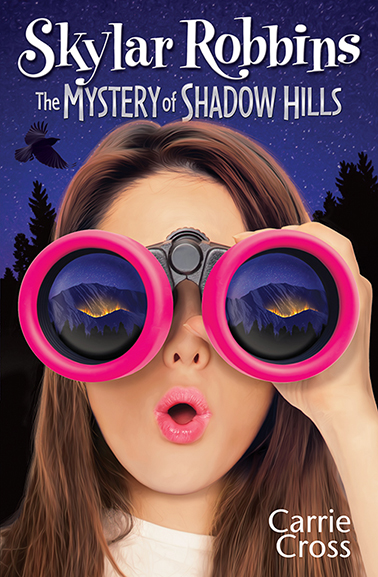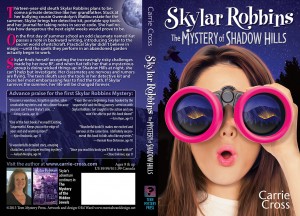
Win your free copy!
CHAPTER 1: My Detective Kit
Heading for Malibu on a sunny Saturday in June would normally have been a good thing. I could have spent the day bodysurfing with my BFF, Alexa, and playing games in the arcade on the Santa Monica pier. If I was totally lucky I might have shared a bumper car with Dustin Coles, the cutest boy going into Pacific Middle School. Alexa and I liked to lie in the sun and watch surfers ride the waves on Zuma beach. If there were pinball and corndogs ahead of me instead of what I was in for, I would have begged my dad for a ride down the coast. But today? Not so much.
If I’d gotten out of the car right then and spread out my beach towel, everything might have turned out fine. But my dad kept right on driving.
We stopped at a red light before heading down the incline to Pacific Coast Highway. Comforted a little by the weight pressing against my leg, I stared out the window and watched the ocean. The faraway water was navy blue where it met the sky. A frosting of whitecaps drifted sideways, winked, and disappeared. The sea was teal-blue in the middle, and the shallow water glowed bright green as if it were lit from below. Small waves welled up, and then the whitewater bubbled forward and sizzled flat on the sand.
Thin sunlight shimmered on the ocean while I tapped my fingers on the detective kit leaning against my leg. I’d always wanted to become a private detective like my grandfather, and used his old leather briefcase to hold my tools. Back when he was a policeman, Grandpa’s case used to be a rich tan color. But after decades of visiting crime scenes, sitting outside in the sun, and baking in a hot cop car, it had faded to grayish beige. There was a burn mark on the bottom from when he’d policed an arson scene. The handle was stained with dark smudges from dusting robbery sites with fingerprinting powder. After he went undercover, the corners got battered from years of being tossed into the trunk of his unmarked car.
I had been adding to my detective kit slowly over the last two years by using my allowance and asking for pieces of equipment for my birthday. The first pocket hid a thin penlight that I used for searching through boxes, suitcases, or suspicious people’s belongings in the dark. Another one held a laser pointer that shot a red beam of light up to a hundred yards. My mom always worried that I would blind myself or someone else with it, but I kept it in case I was ever chased by robbers or someone I needed to blind to save my life. My pink Super-Zoom binoculars, perfect for long-distance spying, rested inside the biggest pocket. A heavy-duty flashlight for nighttime investigations was snug under a strap.
Zipped inside another compartment there was a measuring tape, wax for taking impressions, and a box of chalk in case I had to outline a dead body. I had a pen and sketchpad for describing crime scenes, a magnifying glass, and tweezers and evidence envelopes for picking up and storing clues. There were latex gloves like doctors use, and safety goggles. Pepper spray for self-defense. Best of all was my fingerprinting kit and Case Solution cards for mounting the prints.
I loved my detective kit and everything it stood for. Where I was headed, there was no way I was leaving it behind. Uh-uh. Not today.
The light changed, and we turned onto Pacific Coast Highway and passed the Santa Monica pier. The Ferris wheel spun lazily around, carrying happy people toward the sky. The pink chair at the top of the wheel swung back and forth, empty. I always felt lucky when it was my turn to get on the ride and a pink car stopped in front of me. I didn’t feel lucky today. Wishing I were waiting in line for that ride right now, I looked out the back window and watched the Ferris wheel turn until I couldn’t see it any longer.
A few miles farther up the coast, my mom pointed at a mansion built high up on a cliff. “Look, Honey,” she said to me. The huge house had a wall of windows that faced the ocean. A black Ferrari was parked in the driveway, and a modern metal sculpture dominated the yard. “I bet a movie star lives there. Or a rock star.” She smiled at me over her shoulder. “Maybe that’s Justin Bieber’s house.”
My mom didn’t watch Extra, read People magazine, or download music from iTunes. If it wasn’t in a textbook, she usually didn’t have a clue. “He’s gross, Mom.” My detective kit tipped over when we stopped for a light and I bent sideways to grab the handle and straighten it back up.
“Just because someone can afford a house like that doesn’t mean he’s famous,” my dad said. “Maybe a chemist owns it, for example.” He winked at me in the rear-view mirror and his blue eyes crinkled behind his glasses. Ha ha. My dad’s a chemist. As if we could ever afford a huge beach house. “What do you think, Skylar? Who lives there?” he asked, trying to start one of our old car games like I was a fussy six-year-old.
“Mickey and his roommate Donald?” I stared out the window at the roiling ocean. “I still can’t believe I have to spend the whole summer with Gwendolyn. You know how she is,” I complained, picking at a thread on the seat belt. My cousin and I did not get along. And that was the understatement of the century.
“Gwendolyn acts out because she has low self-esteem,” my mom told me for the millionth time. Like that made it OK.
My dad sped up when we hit a straight part of the coastline. “Just ignore her. If she doesn’t get a reaction she’ll get bored and leave you alone.” His shoulders bunched up and he tapped his fingers quickly against the steering wheel.
“I try to ignore her. It doesn’t do any good. She just gets in my face and asks me if I went deaf.” I flicked the seat belt buckle as we passed a long row of unevenly spaced palm trees.
“Gwendolyn got suspended for a week last semester for bullying that boy in her class, remember?” my dad asked. “I’m sure she’ll be on her best behavior.”
Gwendolyn doesn’t have any best behavior, I thought.
My cousin had picked on me since we were kids. She made fun of me because I was skinny and got good grades. My mom said it just showed that my cousin wished she were thinner and did better in school. But that didn’t make it feel any better when I was at the end of her pointing finger. I remembered what happened two weeks ago on report card day. I got mostly A’s and Gwendolyn barely made C’s. “Gee Skylar, no wonder you don’t have a boyfriend with your nose always stuck in those big, boring books,” Gwendolyn said. “I don’t know how you can stand to be so bo-oh-oh-ring.”
After she’d said that I pulled out a small notepad that I always carry with me. I jotted a note to myself while staring at Gwendolyn with a little smile on my face: I’m not as boring as you think.
So then Gwendolyn whined, “What are you writing?”
I’d won that time. But she got me back after dinner.
“Hey Skylar, are you sure you’re a girl?” Gwendolyn asked, bending over to stare at my flat chest. “You look like a scarecrow.” She walked away, laughing and stuffing cookies into her face.
It seemed like my cousin only smiled when she was laughing at someone else. She had short, frizzy hair and a round face, and she didn’t shower very often. Sometimes she would stand right next to where I was sitting and fart on purpose. Then she’d hold her nose and look at me like I did it.
“It’s not all about Gwendolyn,” I said. “Staying at her house also means I can’t hang out with Alexa for like, forever.” I couldn’t spend the whole summer without my BFF. No way. And it would be impossible for her, too. Especially if she had to go to summer school and I wasn’t there to help her.
“Maybe one Saturday Caroline can give you a ride and you can meet Alexa and her mom halfway. For lunch.” My mom ran a hand through her hair, which was dark brown like mine, except hers was short and wavy while mine was long and straight.
“I don’t want to ‘do lunch’ with Alexa, Mom. I want to be able to ride my bike over to her house and be there in five minutes. Or go swimming, or go to the mall.” Or what if we just want to hang out and spy on boys? I thought, but didn’t say. Wouldn’t have helped my case.
“You’ll meet all sorts of new friends at Malibu Middle School this summer,” my dad said helpfully. He was trying to make me feel better, but the thought of starting a new school just made me nervous. My situation was like the next wave. It was coming whether I liked it or not, and there was nothing I could do to stop it.
My mom craned her neck around and looked at me sympathetically. “I’m sorry we couldn’t take you with us, Honey, but the trip is for the professors and their spouses only. No children are coming. Plus you’d be bored silly. We’re going to visit all the historical monuments I teach about in class. The Berlin Wall—” she laughed, shaking the hair away from her heart-shaped face. “Well actually where the Berlin Wall was….”
“It’s OK, Mom,” I said. Visiting the remains of the Berlin Wall sounded as exciting as a triple helping of detention. But it was still so not OK. “I just don’t see why I couldn’t have stayed at our house.”
“We can’t let you stay home alone for eight weeks, Kiddo,” my dad said, scratching his head through his thin light brown hair. “You’re too young.”
“I’m thirteen, Dad.” I fingered one of the locks on my detective kit, spinning the digits around.
“Exactly.” He put his hand firmly back on the wheel. “Case closed.”
I stared out the window to my right. The rocky hillside was covered with dry tumbleweeds and dead bushes, some still black from last year’s fires. It happened every year when everything was all dried out and the Santa Ana winds blew hot air through the hills. Sometimes a homeless person cooking outside would start a fire by accident, or some crazy person would start one on purpose.
Other times the hillside seemed to burst into flames all by itself. Whenever it got windy and we were at my cousin’s house, Aunt Caroline’s eyes would pinch up at the corners as she squinted out the back window. She’d twist her fingers around as she listened for fire engine sirens, sniffing the air every five seconds to see if she smelled smoke.
The mountain looped and snaked with the coastline, and now there were no plants or trees on the hillside. It was just a wall of striped rock that looked impossible to climb. My parents kept trying to convince me how great my summer would be as we got closer to Gwendolyn’s, which was up in the Malibu hills past Point Dume. Behind her house, a rocky mountain range stretched toward the sky. The face was covered with low bushes and big rocks, creating pockets of light and dark. Each time you looked up at the hillside it looked different. The shadows seemed to move and dance, darting and disappearing with the setting sun. They looked like caves where people or animals could hide.
The locals had nicknamed those mountains, “Shadow Hills.”
Excerpt From: Carrie Cross. “Skylar Robbins: The Mystery of Shadow Hills.” iBooks. https://itunes.apple.com/WebObjects/MZStore.woa/wa/viewBook?id=3484045733971AE645ABB6A57571342A
Available on Amazon
Enter to win a free autographed copy! Post a comment on this website and message your email address to carrie@skylarrobbins.com






 Care to trade a review for a free copy of my book? Please check it out here if you would like to post a review: http://www.instafreebie.com/book/518
Care to trade a review for a free copy of my book? Please check it out here if you would like to post a review: http://www.instafreebie.com/book/518
